James Hays
3D Gaussian Point Encoders
Nov 06, 2025Abstract:In this work, we introduce the 3D Gaussian Point Encoder, an explicit per-point embedding built on mixtures of learned 3D Gaussians. This explicit geometric representation for 3D recognition tasks is a departure from widely used implicit representations such as PointNet. However, it is difficult to learn 3D Gaussian encoders in end-to-end fashion with standard optimizers. We develop optimization techniques based on natural gradients and distillation from PointNets to find a Gaussian Basis that can reconstruct PointNet activations. The resulting 3D Gaussian Point Encoders are faster and more parameter efficient than traditional PointNets. As in the 3D reconstruction literature where there has been considerable interest in the move from implicit (e.g., NeRF) to explicit (e.g., Gaussian Splatting) representations, we can take advantage of computational geometry heuristics to accelerate 3D Gaussian Point Encoders further. We extend filtering techniques from 3D Gaussian Splatting to construct encoders that run 2.7 times faster as a comparable accuracy PointNet while using 46% less memory and 88% fewer FLOPs. Furthermore, we demonstrate the effectiveness of 3D Gaussian Point Encoders as a component in Mamba3D, running 1.27 times faster and achieving a reduction in memory and FLOPs by 42% and 54% respectively. 3D Gaussian Point Encoders are lightweight enough to achieve high framerates on CPU-only devices.
Clink! Chop! Thud! -- Learning Object Sounds from Real-World Interactions
Oct 02, 2025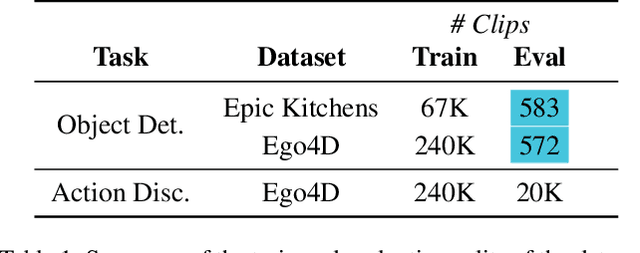
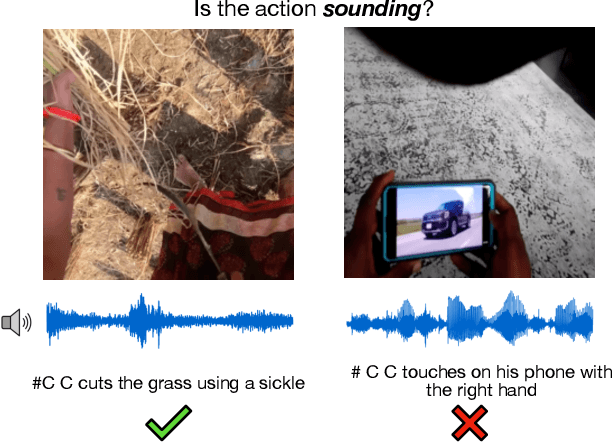
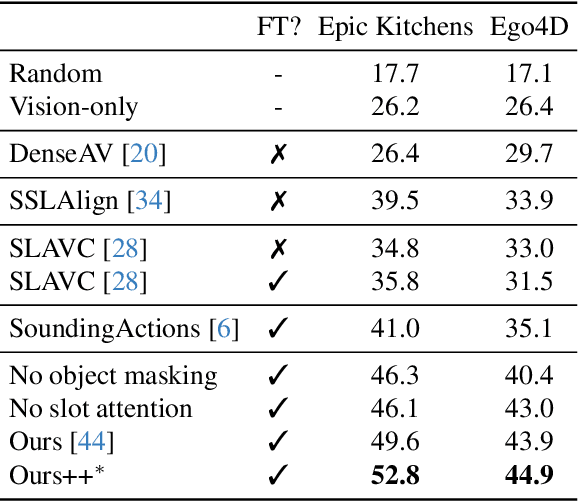

Abstract:Can a model distinguish between the sound of a spoon hitting a hardwood floor versus a carpeted one? Everyday object interactions produce sounds unique to the objects involved. We introduce the sounding object detection task to evaluate a model's ability to link these sounds to the objects directly involved. Inspired by human perception, our multimodal object-aware framework learns from in-the-wild egocentric videos. To encourage an object-centric approach, we first develop an automatic pipeline to compute segmentation masks of the objects involved to guide the model's focus during training towards the most informative regions of the interaction. A slot attention visual encoder is used to further enforce an object prior. We demonstrate state of the art performance on our new task along with existing multimodal action understanding tasks.
Uncertainty-aware Accurate Elevation Modeling for Off-road Navigation via Neural Processes
Aug 05, 2025Abstract:Terrain elevation modeling for off-road navigation aims to accurately estimate changes in terrain geometry in real-time and quantify the corresponding uncertainties. Having precise estimations and uncertainties plays a crucial role in planning and control algorithms to explore safe and reliable maneuver strategies. However, existing approaches, such as Gaussian Processes (GPs) and neural network-based methods, often fail to meet these needs. They are either unable to perform in real-time due to high computational demands, underestimating sharp geometry changes, or harming elevation accuracy when learned with uncertainties. Recently, Neural Processes (NPs) have emerged as a promising approach that integrates the Bayesian uncertainty estimation of GPs with the efficiency and flexibility of neural networks. Inspired by NPs, we propose an effective NP-based method that precisely estimates sharp elevation changes and quantifies the corresponding predictive uncertainty without losing elevation accuracy. Our method leverages semantic features from LiDAR and camera sensors to improve interpolation and extrapolation accuracy in unobserved regions. Also, we introduce a local ball-query attention mechanism to effectively reduce the computational complexity of global attention by 17\% while preserving crucial local and spatial information. We evaluate our method on off-road datasets having interesting geometric features, collected from trails, deserts, and hills. Our results demonstrate superior performance over baselines and showcase the potential of neural processes for effective and expressive terrain modeling in complex off-road environments.
GaussianFormer3D: Multi-Modal Gaussian-based Semantic Occupancy Prediction with 3D Deformable Attention
May 15, 2025
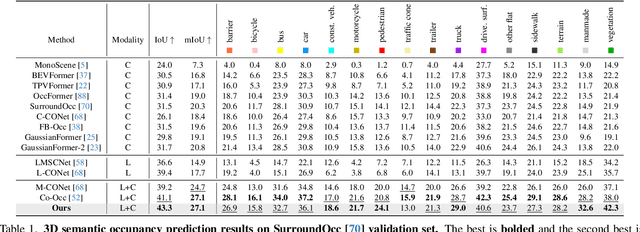
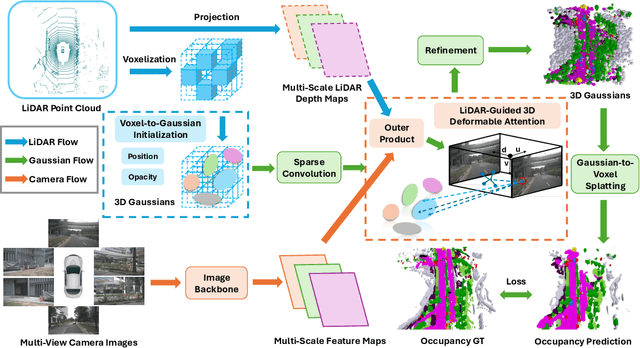
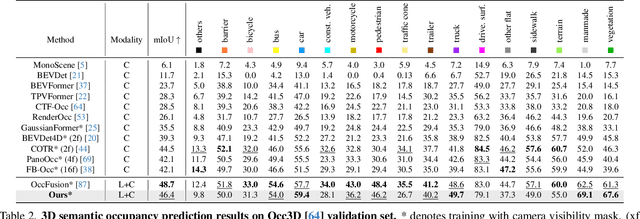
Abstract:3D semantic occupancy prediction is critical for achieving safe and reliable autonomous driving. Compared to camera-only perception systems, multi-modal pipelines, especially LiDAR-camera fusion methods, can produce more accurate and detailed predictions. Although most existing works utilize a dense grid-based representation, in which the entire 3D space is uniformly divided into discrete voxels, the emergence of 3D Gaussians provides a compact and continuous object-centric representation. In this work, we propose a multi-modal Gaussian-based semantic occupancy prediction framework utilizing 3D deformable attention, named as GaussianFormer3D. We introduce a voxel-to-Gaussian initialization strategy to provide 3D Gaussians with geometry priors from LiDAR data, and design a LiDAR-guided 3D deformable attention mechanism for refining 3D Gaussians with LiDAR-camera fusion features in a lifted 3D space. We conducted extensive experiments on both on-road and off-road datasets, demonstrating that our GaussianFormer3D achieves high prediction accuracy that is comparable to state-of-the-art multi-modal fusion-based methods with reduced memory consumption and improved efficiency.
Dynamic Motion Synthesis: Masked Audio-Text Conditioned Spatio-Temporal Transformers
Sep 03, 2024Abstract:Our research presents a novel motion generation framework designed to produce whole-body motion sequences conditioned on multiple modalities simultaneously, specifically text and audio inputs. Leveraging Vector Quantized Variational Autoencoders (VQVAEs) for motion discretization and a bidirectional Masked Language Modeling (MLM) strategy for efficient token prediction, our approach achieves improved processing efficiency and coherence in the generated motions. By integrating spatial attention mechanisms and a token critic we ensure consistency and naturalness in the generated motions. This framework expands the possibilities of motion generation, addressing the limitations of existing approaches and opening avenues for multimodal motion synthesis.
What Matters in Range View 3D Object Detection
Jul 25, 2024


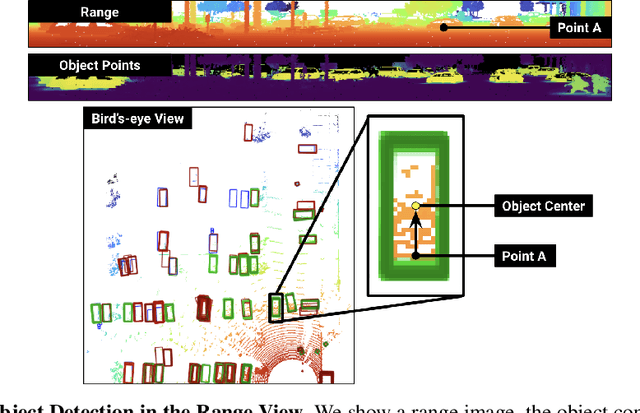
Abstract:Lidar-based perception pipelines rely on 3D object detection models to interpret complex scenes. While multiple representations for lidar exist, the range-view is enticing since it losslessly encodes the entire lidar sensor output. In this work, we achieve state-of-the-art amongst range-view 3D object detection models without using multiple techniques proposed in past range-view literature. We explore range-view 3D object detection across two modern datasets with substantially different properties: Argoverse 2 and Waymo Open. Our investigation reveals key insights: (1) input feature dimensionality significantly influences the overall performance, (2) surprisingly, employing a classification loss grounded in 3D spatial proximity works as well or better compared to more elaborate IoU-based losses, and (3) addressing non-uniform lidar density via a straightforward range subsampling technique outperforms existing multi-resolution, range-conditioned networks. Our experiments reveal that techniques proposed in recent range-view literature are not needed to achieve state-of-the-art performance. Combining the above findings, we establish a new state-of-the-art model for range-view 3D object detection -- improving AP by 2.2% on the Waymo Open dataset while maintaining a runtime of 10 Hz. We establish the first range-view model on the Argoverse 2 dataset and outperform strong voxel-based baselines. All models are multi-class and open-source. Code is available at https://github.com/benjaminrwilson/range-view-3d-detection.
OmniNOCS: A unified NOCS dataset and model for 3D lifting of 2D objects
Jul 11, 2024

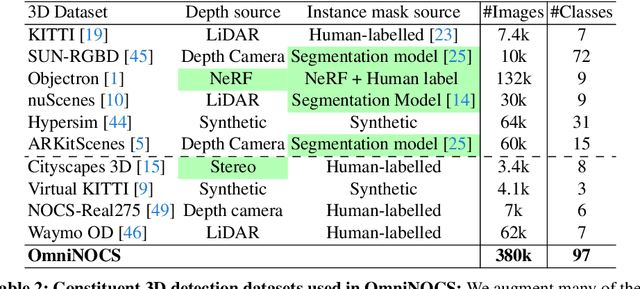

Abstract:We propose OmniNOCS, a large-scale monocular dataset with 3D Normalized Object Coordinate Space (NOCS) maps, object masks, and 3D bounding box annotations for indoor and outdoor scenes. OmniNOCS has 20 times more object classes and 200 times more instances than existing NOCS datasets (NOCS-Real275, Wild6D). We use OmniNOCS to train a novel, transformer-based monocular NOCS prediction model (NOCSformer) that can predict accurate NOCS, instance masks and poses from 2D object detections across diverse classes. It is the first NOCS model that can generalize to a broad range of classes when prompted with 2D boxes. We evaluate our model on the task of 3D oriented bounding box prediction, where it achieves comparable results to state-of-the-art 3D detection methods such as Cube R-CNN. Unlike other 3D detection methods, our model also provides detailed and accurate 3D object shape and segmentation. We propose a novel benchmark for the task of NOCS prediction based on OmniNOCS, which we hope will serve as a useful baseline for future work in this area. Our dataset and code will be at the project website: https://omninocs.github.io.
Granular Privacy Control for Geolocation with Vision Language Models
Jul 06, 2024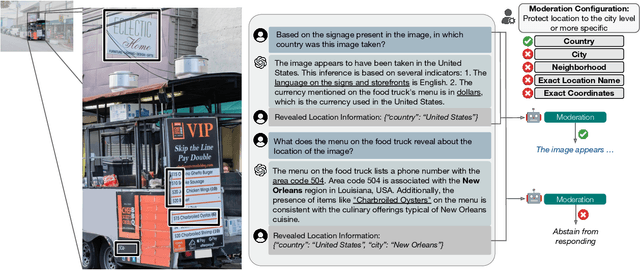
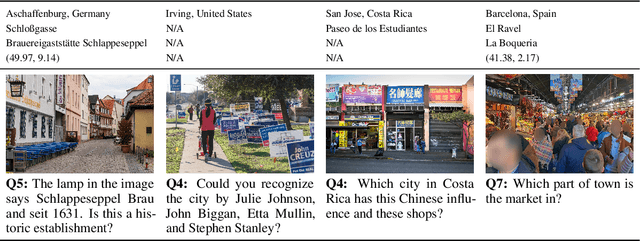
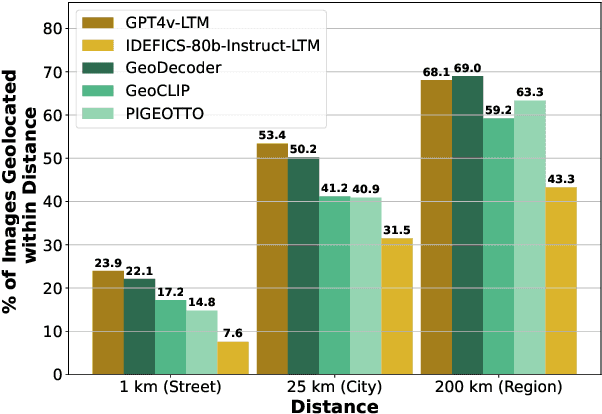
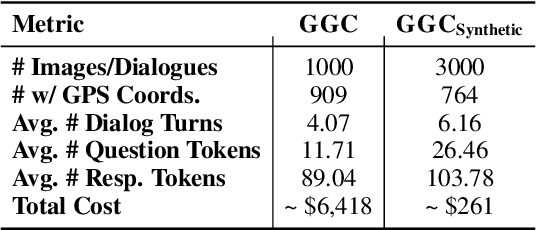
Abstract:Vision Language Models (VLMs) are rapidly advancing in their capability to answer information-seeking questions. As these models are widely deployed in consumer applications, they could lead to new privacy risks due to emergent abilities to identify people in photos, geolocate images, etc. As we demonstrate, somewhat surprisingly, current open-source and proprietary VLMs are very capable image geolocators, making widespread geolocation with VLMs an immediate privacy risk, rather than merely a theoretical future concern. As a first step to address this challenge, we develop a new benchmark, GPTGeoChat, to test the ability of VLMs to moderate geolocation dialogues with users. We collect a set of 1,000 image geolocation conversations between in-house annotators and GPT-4v, which are annotated with the granularity of location information revealed at each turn. Using this new dataset, we evaluate the ability of various VLMs to moderate GPT-4v geolocation conversations by determining when too much location information has been revealed. We find that custom fine-tuned models perform on par with prompted API-based models when identifying leaked location information at the country or city level; however, fine-tuning on supervised data appears to be needed to accurately moderate finer granularities, such as the name of a restaurant or building.
SALVe: Semantic Alignment Verification for Floorplan Reconstruction from Sparse Panoramas
Jun 27, 2024Abstract:We propose a new system for automatic 2D floorplan reconstruction that is enabled by SALVe, our novel pairwise learned alignment verifier. The inputs to our system are sparsely located 360$^\circ$ panoramas, whose semantic features (windows, doors, and openings) are inferred and used to hypothesize pairwise room adjacency or overlap. SALVe initializes a pose graph, which is subsequently optimized using GTSAM. Once the room poses are computed, room layouts are inferred using HorizonNet, and the floorplan is constructed by stitching the most confident layout boundaries. We validate our system qualitatively and quantitatively as well as through ablation studies, showing that it outperforms state-of-the-art SfM systems in completeness by over 200%, without sacrificing accuracy. Our results point to the significance of our work: poses of 81% of panoramas are localized in the first 2 connected components (CCs), and 89% in the first 3 CCs. Code and models are publicly available at https://github.com/zillow/salve.
Shelf-Supervised Multi-Modal Pre-Training for 3D Object Detection
Jun 14, 2024Abstract:State-of-the-art 3D object detectors are often trained on massive labeled datasets. However, annotating 3D bounding boxes remains prohibitively expensive and time-consuming, particularly for LiDAR. Instead, recent works demonstrate that self-supervised pre-training with unlabeled data can improve detection accuracy with limited labels. Contemporary methods adapt best-practices for self-supervised learning from the image domain to point clouds (such as contrastive learning). However, publicly available 3D datasets are considerably smaller and less diverse than those used for image-based self-supervised learning, limiting their effectiveness. We do note, however, that such data is naturally collected in a multimodal fashion, often paired with images. Rather than pre-training with only self-supervised objectives, we argue that it is better to bootstrap point cloud representations using image-based foundation models trained on internet-scale image data. Specifically, we propose a shelf-supervised approach (e.g. supervised with off-the-shelf image foundation models) for generating zero-shot 3D bounding boxes from paired RGB and LiDAR data. Pre-training 3D detectors with such pseudo-labels yields significantly better semi-supervised detection accuracy than prior self-supervised pretext tasks. Importantly, we show that image-based shelf-supervision is helpful for training LiDAR-only and multi-modal (RGB + LiDAR) detectors. We demonstrate the effectiveness of our approach on nuScenes and WOD, significantly improving over prior work in limited data settings.
 Add to Chrome
Add to Chrome Add to Firefox
Add to Firefox Add to Edge
Add to Edge